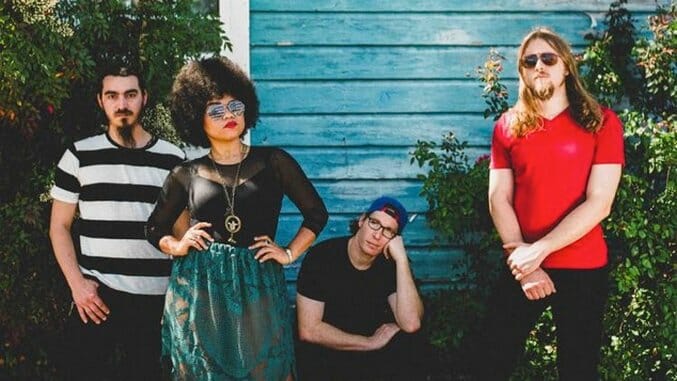Seratones: The Best of What’s Next
Making a Dollar Out of Fifty Cents

It’s extremely hard to follow along when the four Shreveport, Louisiana natives in rising band Seratones tell a story. It’s not because there isn’t a plot, or because they’re boring or talking too fast or they’re telling things out of order. Rather, it seems like every story leads to a different story and reminds them of this one time or this place or the show they played. All of a sudden, you’re knee-deep in a simple question about the band’s background, and you’ve already heard 10 plots, involving everything from DIY punk shows to teen jazz aficionados to a band named Sunday Mass Murder.
“It is a righteous band name,” laughs lead singer AJ Haynes. She’s recounting bass player Adam Davis’ stint fronting a very different kind of band—a common feat among Seratones, who have played together in different combinations for about a decade. “You used to scare the shit out of me when I was 18.”
Haynes’ path to fronting the blues-informed, rock-centric, gospel-tinged amalgamation that’s winning hearts as Seratones right now has its own share of pit stops. She found her voice thanks to a congregation at a rural Baptist church, following the lead of her choir director.
“From there, I really fell in love with a lot of jazz singers,” says Haynes. “In high school, I listened to just a bunch of jazz music and then [the rest of the band] introduced me to punk music. They go together like peanut butter and jelly, you know? Punk and jazz.”
When Haynes says that last part, everybody laughs, but no one says she’s wrong; The band have built their creative confidence out of seemingly odd pairings. Davis and Haynes cite their work at the McNeill Pumping Station, an old waterworks museum in Shreveport where they arranged a community art installation, as just one of countless off-the-wall endeavors that led them to where they are. For that, they invited musicians and artists to use the museum itself as the instrument, setting up microphones in aquariums or banging on pipes to create reverberation.
“There’s not really a sound. There’s more like an attitude from Shreveport. You can’t quite put your finger on it. But because there’s not an infrastructure for like, the music industry, we have to do things ourselves,” she says. “The artistic community is very very close knit, and everyone supports each other. We’re just all trying to make a lot with what we have, trying to make a lot out of a little, trying to make a dollar out of fifty cents.”
You hear evidence of that close-knit community constantly, from the almost homesick way Haynes and her bandmates refer to the chaos of their practice space, a room in the Shreveport location of Tipitina’s Music Foundation, or in the familial mention of Shreveport talent from Cloud Breather to Brittany Maddox.